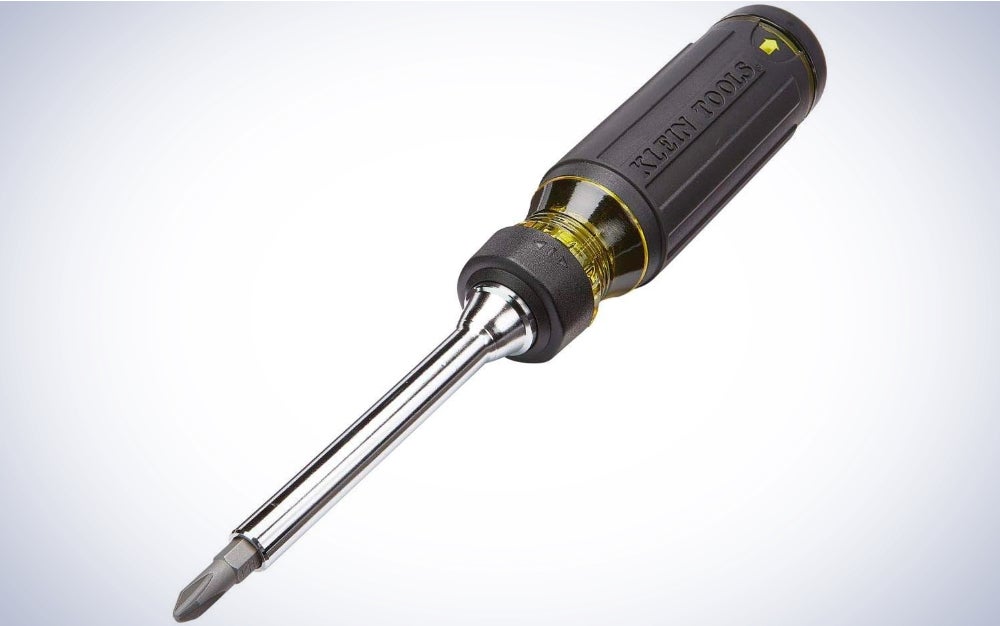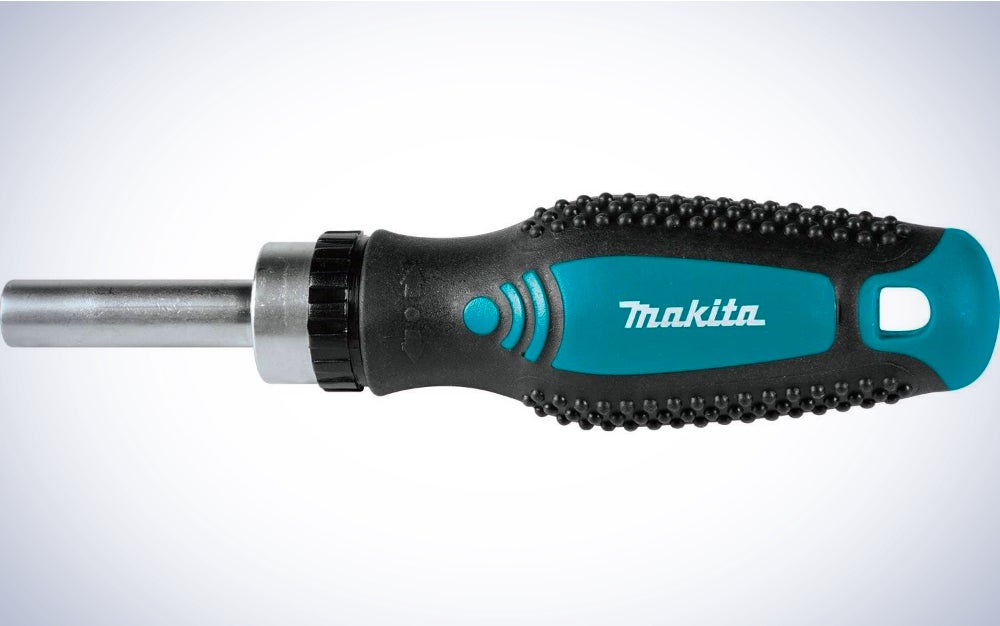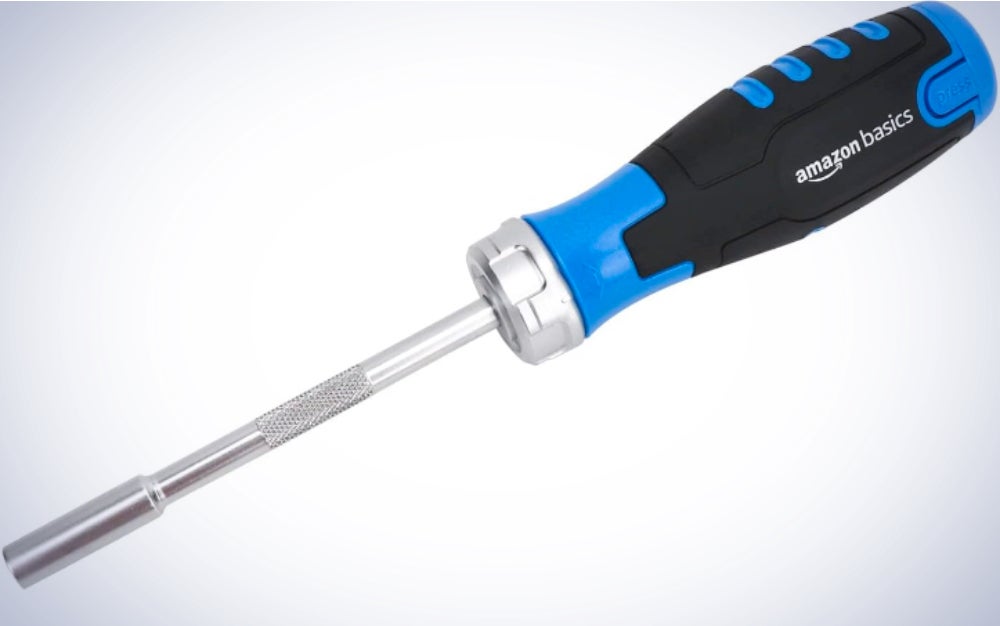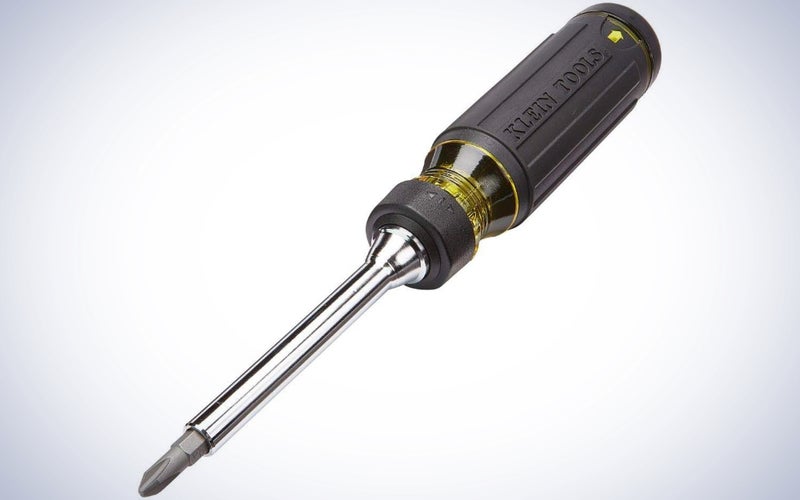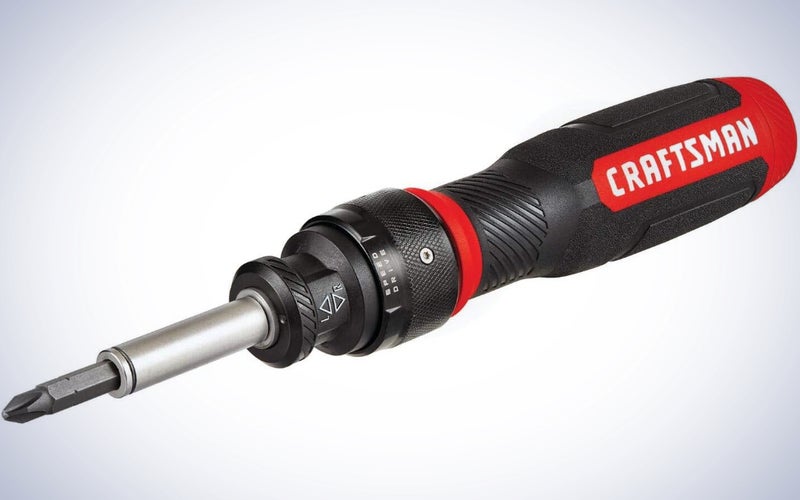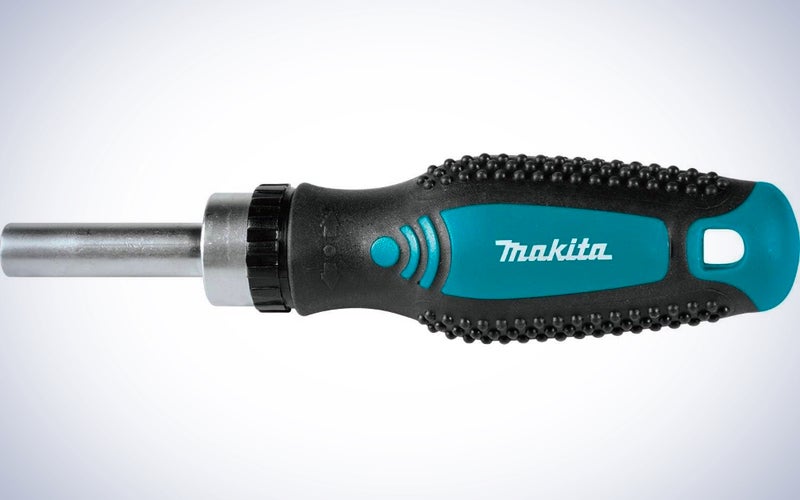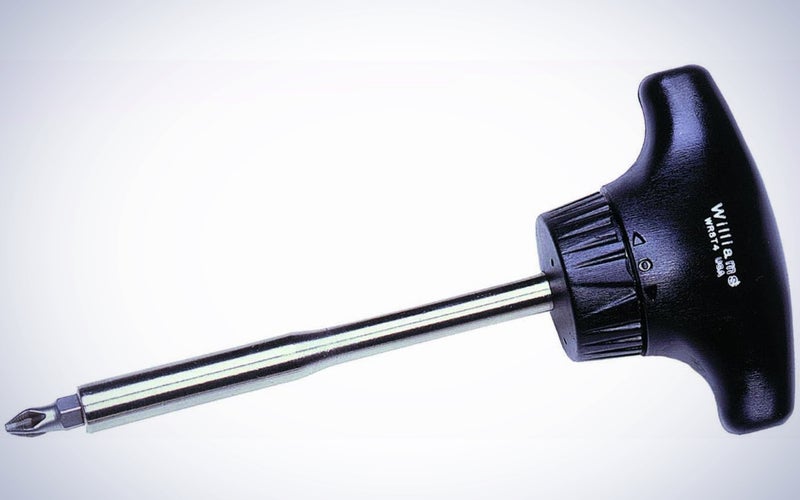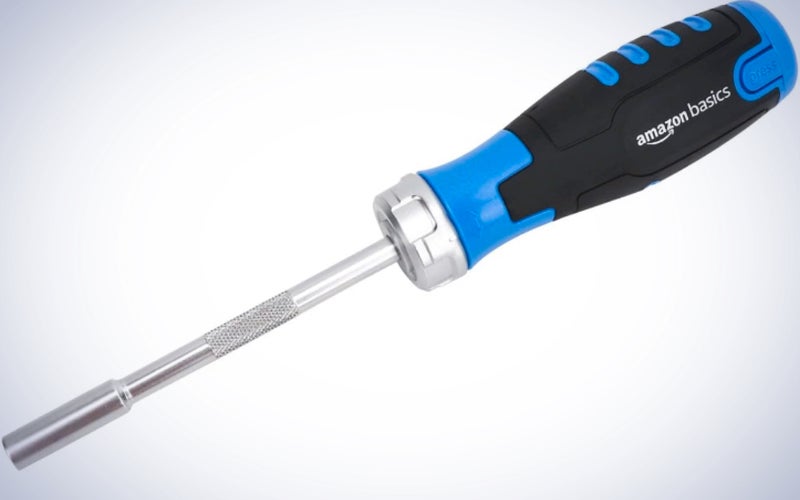We may earn revenue from the products available on this page and participate in affiliate programs. Learn more ›
A ratcheting screwdriver is one of those tools you didn’t know you needed and then wondered how you did without. They are simple yet effective and popular with engineers, electricians, model makers, DIYers, and anyone else who works with screws or small nuts and bolts regularly. They are faster than a standard screwdriver and usually more comfortable to use. In this article, we examine the wide variety of models available and talk about the key features that will impact choice. We also closely examine what we think are the best ratcheting screwdrivers on the market right now.
- Best overall: Klein Tools 32305 Multi-bit Ratcheting Screwdriver
- Best grip: Wera 05073661002 Slotted Ratcheting Screwdriver
- Best speed: Craftsman SpeedDrive Ratcheting Screwdriver
- Best kit: Makita B-50289 47 Pc. Ratchet and Bit Set
- Best T-handle: Williams WRST4 Ratcheting Screwdriver
- Best budget: Amazon Basics 12-in-1 Magnetic Ratchet Screwdriver
How we chose the best ratcheting screwdrivers
As a qualified engineer and keen DIYer, I know the benefits offered by ratcheting screwdrivers and have used them regularly. In addition to my experience with many types of different tools, we surveyed the market to get an understanding of what is available today. Finally, we checked what owners have to say to get some feedback on real-world performance and durability. What we ended up with are choices we’d be happy to have in our toolbox.
The best ratcheting screwdrivers: Reviews & Recommendations
After some consideration, we eventually chose six key categories that allowed us to showcase what we feel are the best ratcheting screwdrivers for a wide variety of purposes and different end users. Just be sure to operate all your tools safely.
Best overall: Klein Tools 32305 Multi-bit Ratcheting Screwdriver
Klein Tools
Specs
- Length: 8.71 inches
- Handle Material: Cushion grip plastic
- Bits Provided: 14 plus nut driver
- Bit Storage: Onboard
Pros
- High-quality tool from a renowned US manufacturer
- High-strength carbon steel barrel with rust-resistant finish
- 14 heat-treated bits with storage in the handle
Cons
- Storage dividers occasionally break
- 1 bit needs to stay in the screwdriver
Klein Tools has been around since 1857, and most of its manufacturing, including its screwdrivers, is done in the US. They have a reputation for durable, high-quality equipment that is particularly popular with professional electricians.
The Klein Tools 3205 ratcheting screwdriver is a fine example of the elements that make these devices so useful. The main shaft is strong carbon steel with a bright coating to prevent rust. At the front of the handle is the ratchet mechanism with forward, reverse, and lock positions. The handle itself has what Klein Tools call a Cushion-Grip, which is soft plastic designed to maximize comfort and torque.
The 3205 has 14 heat-treated double-ended bits included. These are a mix of Phillips, slotted, square, combo, and Torx. They are held in place in the shaft by a ball-bearing detent rather than a magnet. Twelve of these can be carried inside the handle but two have to remain in the end of the screwdriver which not everyone cares for. When not occupied by a bit, the end of the shaft can be used as a 1/4” nut driver.
Best grip: Wera 05073661002 Slotted Ratcheting Screwdriver
Wera
Specs
- Length: 9.06 inches
- Handle Material: Bi-material Plastic
- Bits Provided: 6
- Bit Storage: Onboard
Pros
- Ergonomic handle is comfortable and generates tremendous torque
- 44-tooth ratchet allows fine adjustment
- Stainless steel shaft is strong and will not rust
Cons
- Comes with a premium price tag
- Only 6 bits included
German manufacturer Wera Tools developed its unique screwdriver handle with the help of the Fraunhofer Institute for Industrial Engineering, a company that specializes in the interaction between humans and the equipment they work with. The ergonomic design has two functions. First, it allows maximum torque to be applied. It is rated for up to 50 Newton meters (Nm), which is equal to 37 foot-pounds (ft.lbs.). Second, it reduces stress and abrasion, thus helping to prevent tiredness and blisters. Usefully, it also stops the screwdriver rolling off a table or workbench.
Other aspects of the Wera ratcheting screwdriver underline its quality. The shaft is stainless steel, which is more expensive than other steels but strong and will not rust. A powerful magnet holds bits in place. The ratcheting mechanism has 44 teeth giving an 8-degree pitch, so small turns and therefore fine adjustments are possible.
The six slotted, Phillips, and Torx bits included are carried within the handle. Given the premium price, we’re a little surprised more aren’t supplied though bit sets are widely available and not expensive.
Best speed: Craftsman SpeedDrive Ratcheting Screwdriver
CRAFTSMAN
Specs
- Length: 11.3 inches
- Handle Material: Bi-material plastic
- Bits Provided: 14
- Bit Storage: Onboard
Pros
- Patented SpeedDrive for rapid working
- Positive locking bit holder
- Bi-material handle textured for better grip
Cons
- One bit stays in the screwdriver
- A few people found bits hard to remove
Craftsman has been supplying tools in the US since 1927, and the company’s reputation has always been one of providing great value for money. This ratcheting screwdriver costs very little money and, along with the features found on many rivals, has a patented SpeedDrive mechanism that is claimed to be twice as fast as alternatives. For those who work with a screwdriver in production or repair environments, this can be a major benefit.
Another interesting feature was the locking bit holder that grips small slots in the Craftsman double-ended bits to prevent them from coming loose. Whether this is any more secure than detent ball bearings or a strong magnet is a matter of debate. A few people thought it a little too effective and found bits difficult to remove.
A combination of 14 double-ended bits is provided in slotted, Phillips, square, and Torx formats. Twelve can be stored in the soft-grip, textured handle, but one must stay in the shaft. At 11.3 inches, the Craftsman ratcheting screwdriver is quite long. A lot of that length is the handle, and while that does allow good torque, the shaft is relatively short, so it doesn’t offer particularly good reach.
Best kit: Makita B-50289 47 Pc. Ratchet and Bit Set
Makita
Specs
- Length: 6.25 inches
- Handle Material: Rubberized Plastic
- Bits Provided: 46
- Bit Storage: Case
Pros
- Good variety of bits, sockets, and a quick-change adapter
- Textured, rubberized handle provides excellent grip
- Storage case gives easy access
Cons
- Handle may not suit small hands
- A few reports of mechanism breakages
For those who work on a wide variety of different devices, Makita’s 47-piece ratchet and bit set may well be the answer, especially given the very reasonable price. There are 38 screwdriver bits in slotted, Phillips, square, hex, and Torx formats, plus seven sockets ranging from 3/16-inch to 7/16-inch. There is also a quick-change adapter that can accept all of those items and allows them to be used in drills/drivers and impact drivers.
The ratcheting screwdriver itself has a steel shaft with a magnetic bit holder that will take bit lengths of up to 1- inch. The handle is a chunky item made of rubberized plastic with raised pimples. There’s also a lanyard/hanging hole that some might find useful. The handle does provide good grip, but is quite bulky and might be difficult for those with small hands.
The case is well made with everything laid out for easy access though a few people thought the bits could be awkward to remove.
Best T-handle: Williams WRST4 Ratcheting Screwdriver
Williams
Specs
- Length: 2, 3-7/8, and 7-7/8 inches
- Handle Material: High-impact plastic
- Bits Provided: 1
- Bit Storage: None
Pros
- Impact-resistant handle applies good leverage
- Three lengths available to suit different tasks
- Stainless steel shaft will not rust
Cons
- Relatively high price
- Only one bit included
Williams Industrial Tools is another long-standing company, having been around for over 140 years. As the name suggests, the focus is on heavy-duty equipment for tough working environments. In the case of their ratcheting screwdriver, this means a handle made from impact-resistant plastic, a highly durable mechanism, and a shaft made from stainless steel, which won’t rust and has no need of a finish that might chip off over time.
T-handles offer good ergonomics, and as the bulk of the length is shaft, they can provide good reach in awkward places. They also make it easier to generate leverage than standard handles. The Williams ratcheting screwdriver is available in three lengths from a stubby 2-inch model, through 3-7/8-inch to 7-7/8-inch. Only one Phillips bit is included, and while others are readily available, a few more might have been expected for the price.
Best budget: Amazon Basics 12-in-1 Magnetic Ratchet Screwdriver
Amazon
Specs
- Length: 9.3 inches
- Handle Material: Non-slip plastic
- Bits Provided: 12
- Bit Storage: Onboard
Pros
- Competitive specification for less money than most rivals
- Corrosion-resistant chrome vanadium shaft
- Single bits rather than double-ended
Cons
- Ratchet mechanism occasionally jams
- Magnetism can be weak
The Amazon ratcheting screwdriver might be called Basic, but it is anything but in many ways. The shaft is made of chrome vanadium steel which is a popular choice for making tools as it is strong, and corrosion resistant. It uses a common forward, reverse or fixed mechanism, and the plastic handle has enough grip to provide a confident hold. The base is free-spinning so fingers can be used to turn the handle while pressure is applied to the rear.
There are 12 single bits, which some people prefer to the double-ended type. They are slotted, Phillips, Torx, and hex. All of them can be stored within the handle. The shaft tip is magnetic to hold them in place, though some owners felt the strength was rather weak. The ratchet mechanism itself also came in for occasional criticism with a few owners experiencing jams or breakages.
What to consider when shopping for the best ratcheting screwdrivers
All the ratcheting screwdrivers we looked at have a similar mechanism, but there are a number of individual features that are likely to have an impact on your choice. The following section explains them in depth.
Operation & comfort
The benefit of a ratcheting screwdriver is that the mechanism allows force to be applied in one direction (either forward or reverse) but spins freely in the other. This allows screws or nuts to be tightened or loosened without breaking contact. The result is increased driving speed. Additionally, using a ratcheting screwdriver for long periods is often less tiring. Some have a spin cap that allows the main body to be turned with the fingers while the palm applies pressure. Most ratcheting screwdrivers have forward, reverse, and a central lock position where they act like a fixed screwdriver.
Handles are often made of a soft-grip or rubberized plastic that not only makes them more comfortable to work with but may also increase the torque (twisting force) that can be applied. T-handle ratchet screwdrivers have the same kind of mechanism, but some people prefer that style of grip. It also provides additional leverage.
Shape & reach
A quick check of the images of the different models in our top six will reveal that bodies have a number of different shapes. Some of this is to provide comfort or increase torque, but personal preference is equally important. If you don’t like the shape, you’ll struggle to use it effectively, whatever the supposed benefits.
Reach is another important area. Sometimes screws are buried deep within a device and a long shank is needed. At other times space is limited, so a ‘stubby’ ratcheting screwdriver will be required. Many people will end up with several to cope with all situations.
Bits & bit storage
We looked at several dozen different ratcheting screwdrivers when researching this article, and all of them take universal 1/4” bits. Some also take hex sockets, and there are adapters that allow other sizes to be used. The devices you work on will dictate how important each of these is.
There are also many styles of bit. Typically slotted, Phillips, and Torx (also called star) will be provided, but others may be included. While they can always be bought as extras, it’s useful to have the ones you need most supplied with the screwdriver.
Many ratcheting screwdrivers store bits within the screwdriver body. This provides convenient access and means they take up less space in your toolbox. Larger sets usually come in a storage case. It’s worth checking the quality of this because it can be frustrating if it breaks, and another way of keeping the bits together has to be found.
FAQs
Q: Do ratcheting screwdrivers take ordinary screwdriver bits?
Yes, all the ratcheting screwdrivers we found take the ordinary (also called universal) 1/4” bit. It’s also possible for them to take sockets.
Q: Are ratcheting screwdrivers magnetic?
Some ratcheting screwdrivers are magnetic. Others have detents—small indentations inside the shaft. A sprung ball bearing in the screwdriver bit fits into the detent when inserted and stops it dropping out.
Q: Is a ratcheting screwdriver worth it?
A ratcheting screwdriver is definitely worth it if you regularly work with screws because it enables you to tighten and loosen them more quickly and with less effort than a standard screwdriver.
Q: How much do ratcheting screwdrivers cost?
Our recommendations cost between $13.27 and $41.07.
Final thoughts on choosing the best ratcheting screwdrivers for you
- Best overall: Klein Tools 32305 Multi-bit Ratcheting Screwdriver
- Best grip: Wera 05073661002 Slotted Ratcheting Screwdriver
- Best speed: Craftsman SpeedDrive Ratcheting Screwdriver
- Best kit: Makita B-50289 47 Pc. Ratchet and Bit Set
- Best T-handle: Williams WRST4 Ratcheting Screwdriver
- Best budget: Amazon Basics 12-in-1 Magnetic Ratchet Screwdriver
Although all ratcheting screwdrivers work in basically the same way, construction quality and materials vary. Brand reputation had a bearing on our choices because some manufacturers are known for supplying premium tools, while others are recognized for their value for money. We also looked at the number and variety of bits provided; for convenience, it’s nice to have either onboard bit holders or a storage case. We believe that there is something in our selection above that can make the job easier for everyone.
Why trust us
Popular Science started writing about technology more than 150 years ago. There was no such thing as “gadget writing” when we published our first issue in 1872, but if there was, our mission to demystify the world of innovation for everyday readers means we would have been all over it. Here in the present, PopSci is fully committed to helping readers navigate the increasingly intimidating array of devices on the market right now.
Our writers and editors have combined decades of experience covering and reviewing consumer electronics. We each have our own obsessive specialties—from high-end audio to video games to cameras and beyond—but when we’re reviewing devices outside of our immediate wheelhouses, we do our best to seek out trustworthy voices and opinions to help guide people to the very best recommendations. We know we don’t know everything, but we’re excited to live through the analysis paralysis that internet shopping can spur so readers don’t have to.

